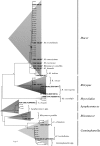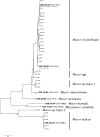Spectrum of zygomycete species identified in clinically significant specimens in the United States
- PMID: 19386856
- PMCID: PMC2691065
- DOI: 10.1128/JCM.00036-09
Spectrum of zygomycete species identified in clinically significant specimens in the United States
Abstract
Several members of the order Mucorales (subphylum Mucoromycotina) are important agents of severe human infections. The identification of these fungi by using standard mycologic methods is often difficult and time consuming. Frequently, the etiological agent in clinical cases is reported either as a Mucor sp., which is not the most frequent genus of zygomycetes, or only as a member of the Mucorales. For this reason, the actual spectrum of species of zygomycetes and their incidences in the clinical setting is not well known. The goals of this study were to compare the results of the molecular identification of an important set of clinical isolates, received in a mycological reference center from different regions of the United States, with those obtained by using the traditional morphological methods and to determine the spectrum of species involved. We tested 190 isolates morphologically identified as zygomycetes by using sequencing of the internal transcribed spacer (ITS) region of the ribosomal DNA. Molecular identification revealed that Rhizopus oryzae represented approximately half (44.7%) of these isolates. The remainder was identified as Rhizopus microsporus (22.1%), Mucor circinelloides (9.5%), Mycocladus corymbifer (formerly Absidia corymbifera) (5.3%), Rhizomucor pusillus (3.7%), Cunninghamella bertholletiae (3.2%), Mucor indicus (2.6%), Cunninghamella echinulata (1%), and Apophysomyces elegans (0.5%). The most common anatomic sites for clinically significant zygomycetes, as determined by isolates sent to the Fungus Testing Laboratory for identification and/or susceptibility testing and included in this study, were the sinuses, lungs, and various cutaneous locations, at 25.8%, 26.8%, and 28%, respectively. These sites represented approximately 80% of the isolates evaluated. A high level of correlation (92.6%) between morphological and molecular identifications was found.
Figures


Similar articles
-
Molecular identification of zygomycetes from culture and experimentally infected tissues.J Clin Microbiol. 2006 Feb;44(2):340-9. doi: 10.1128/JCM.44.2.340-349.2006. J Clin Microbiol. 2006. PMID: 16455881 Free PMC article.
-
Molecular detection and identification of zygomycetes species from paraffin-embedded tissues in a murine model of disseminated zygomycosis: a collaborative European Society of Clinical Microbiology and Infectious Diseases (ESCMID) Fungal Infection Study Group (EFISG) evaluation.J Clin Microbiol. 2010 Jun;48(6):2043-6. doi: 10.1128/JCM.02319-09. Epub 2010 Apr 7. J Clin Microbiol. 2010. PMID: 20375233 Free PMC article.
-
Species recognition and clinical relevance of the zygomycetous genus Lichtheimia (syn. Absidia pro parte, Mycocladus).J Clin Microbiol. 2010 Jun;48(6):2154-70. doi: 10.1128/JCM.01744-09. Epub 2010 Mar 31. J Clin Microbiol. 2010. PMID: 20357218 Free PMC article.
-
Animal models of zygomycosis--Absidia, Rhizopus, Rhizomucor, and Cunninghamella.Mycopathologia. 2001;152(1):5-13. doi: 10.1023/a:1011900630987. Mycopathologia. 2001. PMID: 11694096 Review.
-
Molecular tools for identification of Zygomycetes and the diagnosis of zygomycosis.Clin Microbiol Infect. 2009 Oct;15 Suppl 5:66-70. doi: 10.1111/j.1469-0691.2009.02983.x. Clin Microbiol Infect. 2009. PMID: 19754761 Review.
Cited by
-
In vitro and in vivo antifungal susceptibilities of the Mucoralean fungus Cunninghamella.Antimicrob Agents Chemother. 2010 Nov;54(11):4550-5. doi: 10.1128/AAC.00786-10. Epub 2010 Aug 30. Antimicrob Agents Chemother. 2010. PMID: 20805397 Free PMC article.
-
Peritoneal dialysis-associated peritonitis from pauci-septated mold: Life-threatening but curable.Med Mycol Case Rep. 2023 Sep 28;42:100612. doi: 10.1016/j.mmcr.2023.100612. eCollection 2023 Dec. Med Mycol Case Rep. 2023. PMID: 37854361 Free PMC article.
-
Outbreak of Invasive Wound Mucormycosis in a Burn Unit Due to Multiple Strains of Mucor circinelloides f. circinelloides Resolved by Whole-Genome Sequencing.mBio. 2018 Apr 24;9(2):e00573-18. doi: 10.1128/mBio.00573-18. mBio. 2018. PMID: 29691339 Free PMC article.
-
Mucormycosis: A rare entity with rising clinical presentation in immunocompromised hosts.Int J Surg Case Rep. 2020;77:57-61. doi: 10.1016/j.ijscr.2020.10.075. Epub 2020 Oct 22. Int J Surg Case Rep. 2020. PMID: 33152595 Free PMC article.
-
Rediscovering the chemistry of the Cunninghamella species: potential fungi for metabolites and enzymes of biological, industrial, and environmental values.RSC Adv. 2024 Dec 5;14(51):38311-38334. doi: 10.1039/d4ra07187e. eCollection 2024 Nov 25. RSC Adv. 2024. PMID: 39640949 Free PMC article. Review.
References
-
- Altschul, S. F., W. Gish, W. Miller, E. W. Myers, and D. J. Lipman. 1990. Basic local alignment search tool. J. Mol. Biol. 215403-410. - PubMed
-
- Arnáiz-García, M. E., D. Alonso-Peña, M. C. González-Vela, J. D. García-Palomo, J. R. Sanz-Gimenéz-Rico, and A. M. Arnáiz-García. Cutaneous mucormycosis: report of five cases and review of the literature. J. Plast. Reconstr. Surg., in press. - PubMed
-
- Bal, A. M. 2006. Importance of identification of zygomycetes in the era of newer antifungal agents. Transpl. Infect. Dis. 8122-123. - PubMed
-
- Balajee, S. A., A. M. Borman, M. E. Brandt, J. Cano, M. Cuenca-Estrella, E. Dannaoui, J. Guarro, G. Haase, C. C. Kibbler, W. Meyer, K. O'Donnell, C. A. Petti, J. L. Rodriguez-Tudela, D. Sutton, A. Velegraki, and B. L. Wickes. 2009. Sequence-based identification of Aspergillus, Fusarium and Mucorales in the clinical mycology laboratory: where are we and where should we go from here? J. Clin. Microbiol. 47877-884. - PMC - PubMed
Publication types
MeSH terms
Substances
Associated data
- Actions
- Actions
LinkOut - more resources
Full Text Sources
Other Literature Sources
Medical

